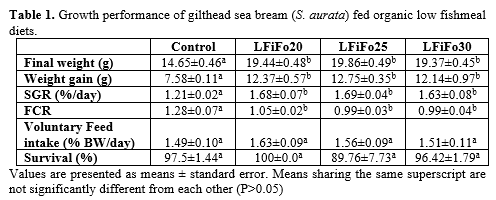GROWTH PERFORMANCE OF GILTHEAD SEABREAM Sparus aurata FED LOW FISHMEAL ORGANIC DIETS
Introduction
Organic aquaculture seems to be a very well promising sector in the global ecology and economy (FiBL & IFOAM, 2020). Organic aquaculture reflects a specific production approach driven by the growing public interest in sustainable utilization of resources (Mente et al., 2011, 2012, 2019; Lembo & Mente, 2019). In the context of sustainability, the search for ingredients that are characterized by low FIFO ratios is of much interest. The aim of this study is to examine the growth performance of sea bream (Sparus aurata) fed diets with a low FIFO mix of ingredients for organic aquaculture.
Materials & Methods
The experimental trial was conducted at the Department of Ichthyology and Aquatic Environment, University of Thessaly. Sea bream individuals with initial mean weight 6.87±0.07g, were acclimated to the laboratory conditions for 15 days before they were randomly distributed into 250l tanks. Each diet was allocated to triplicate groups. The fish were fed three times per day ad libitum and the rearing water quality (21o C, DO>6.5 mg/l) remained stable during the experiment. Four experimental diets were formulated to be isonitrogenous (48.3%), isolipidic (16.2%) and isoenergetic (21.3 KJ/g). The control diet was designed to simulate the composition of a commercial diet incorporating organic fishmeal trimmings, organic fish oil and soybean meal (organic and concentrate). A low FIFO mixture replaced fishmeal at three different inclusion levels, 20, 25 and 30% and three experimental diets were formulated (LFiFo20, LFiFo25 and LFiFo30, respectively). The low FIFO mixture consisted of organic processing fish trimmings, bacterial protein and yeast protein. The duration of the experiment was 60 days. Fish were weighted individually at the beginning and end of the experimental trial under anaesthesia. Feed consumption was recorded daily to evaluate accurately values for feed utilization.
Results
Fish fed the replacement diets (LFiFo20, LFiFo25, LFiFo30) had similar (p>0.05) weight gain and SGR values that were significantly increased (p<0.05) compared to control group of fish. Fish fed the LFiFo20, LFiFo25 and LFiFo30 had also similar (p>0.05) FCR values that were significantly decreased compared to the control group. Voluntary feed intake and survival were statistically unaffected among the diets (p>0.05).
Discussion
Since 2000, there has been an increasing demand for seafood farmed according to certified organic standards, notably in European countries (FGM, 2020). It follows, therefore, that like the terrestrial organic livestock production sector, the onus is on the aquatic nutritionist to formulate an organic feed close to the feed that each fish species is consuming in their natural environment. In the present study, a low FIFO mix with innovative ingredients and organic fishmeal trimmings improved the FCR and enhanced the growth performance of S. aurata. Microbial protein is an alternative source of high‐quality protein able to replace animal protein like fishmeal in livestock nutrition and aquaculture (Matassa et al., 2016; Olmos et al. 2020). Furthermore, yeast meal contain appreciable crude protein (about 40–55%), and other bioactive components beneficiary to fish growth and development (Agboola et al., 2020). The results suggest that wild sourced organic fishmeal trimmings can be successfully replaced by innovative ingredients of low FIFO that are based on microbial protein and yeast meal.
Future research using novel feed ingredients to replace fish meal in organic aquaculture should also take into account the quality of the raw ingredients, their process conditions and the fillet nutritional quality.
Acknowledgement
This project has received funding from the European Union’s Horizon 2020 Innovation Action, FutureEUAqua, under grant agreement No 817737.This output reflects the views only of the author(s), and the European Union cannot be held responsible for any use which may be made of the information contained therein.
References
Agboola, J. O., Øverland, M., Skrede, A., & Hansen, J. Ø. (2020). Yeast as major protein-rich ingredient in aquafeeds: a review of the implications for aquaculture production. Reviews in Aquaculture, September.
FiBL&IFOAM – Organics International (2020): The World of Organic Agriculture, Statistics and Emerging Trends 2020, p.26
FGM, Federation of Greek Maricultures (2020). Aquaculture in Greece 2020: Annual report, p.6
Matassa S., Boon, N., Pikaar, I., Verstraete W. (2016) Microbial protein: future sustainable food supply route with low environmental footprint, Microbial biotechnology, 9 (5), 568-575.
Lembo, P.and Mente, E. (2019). Organic aquaculture impacts and future developments. Springer -Nature Publishers. ISBN 978-3-030-05602-5
Mente, E. Jokumsen, A., Carter, C., Tacon A., Antonopoulou, E. (2019). Nutrition in relation to organic aquaculture: sources and strategies. Chapter 9 in: Organic aquaculture impacts and future developments (Lembo, P and Mente, E. (Editors), Springer-Nature Publishers.
Mente, E., Stratakos, Α. Boziaris, I.S., Kormas, K.A., Karalazos, V., Karapanagiotidis, I.T., Catsiki, A.V., and Leondiadis, L. (2012): The effect of organic and conventional production methods on sea bream growth, health, and body composition; a field experiment. Scientia Marina.
Mente, E., Karalazos, V., Karapanagiotidis, I.T., Pita, C. (2011): Nutrition in organic aquaculture: An inquiry and a discourse. AquacultureNutrition 17, 798 – 817.
Olmos, J., Acosta, M., Mendoza, G., & Pitones, V. (2020). Bacillus subtilis, an ideal probiotic bacterium to shrimp and fish aquaculture that increase feed digestibility, prevent microbial diseases, and avoid water pollution. Archives of Microbiology, 202(3), 427–435.
